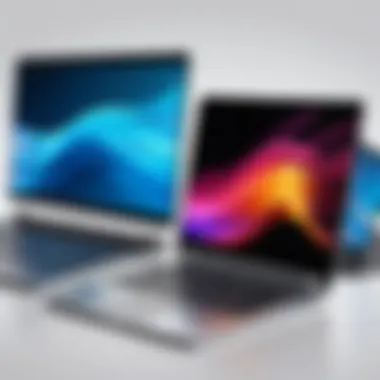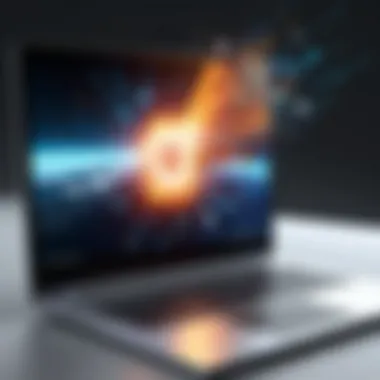Laptops, Tablets, and Notebooks: A Comprehensive Overview


Intro
In the modern digital landscape, the choice of device can significantly impact productivity and personal efficiency. With the continual evolution of technology, laptops, tablets, and notebooks present various strengths and weaknesses tailored to different user needs. This comprehensive overview offers IT professionals and tech enthusiasts a detailed dissection of each device type.
Understanding the distinctions among laptops, tablets, and notebooks is crucial for making informed decisions. Features such as portability, performance, and operating systems determine their suitability for specific tasks. As technology advances, new trends emerge, shaping how we interact with these devices. This piece aims to illuminate these nuances, helping readers navigate the complexities of their choices.
Product Overview
Key Features
Laptops, tablets, and notebooks have unique characteristics that cater to distinct user preferences.
Laptops offer a combination of power and versatility. They feature full-sized keyboards, larger screens, and robust hardware configurations suitable for demanding tasks.
Tablets, on the other hand, prioritize portability. They are lightweight with touchscreens that facilitate intuitive navigation. While they may lack some processing power, advancements have significantly improved their performance.
Notebooks, often seen as a middle ground, are designed for basic tasks. They are thinner and lighter than laptops but lack the performance capabilities important for heavy applications.
Technical Specifications
Understanding technical specifications can aid in comparing these devices:
- Processor: Laptops typically feature Intel Core i5 or i7 processors, enhancing performance for intensive applications. Tablets might utilize ARM processors that balance power and energy efficiency.
- RAM: Laptops often have 8GB or more, suitable for multitasking. In contrast, many tablets still run efficiently with 4GB of RAM.
- Storage: Solid-State Drives (SSDs) are common in laptops, favoring speed over traditional Hard Disk Drives (HDD). Tablets usually have less storage but can utilize cloud solutions.
In summary, when evaluating devices, a user should consider specifications tailored to their individual needs.
Performance Analysis
Benchmark Test Results
Benchmark tests provide quantitative measures of performance. In general, laptops outperform tablets in benchmark scores due to superior processors and RAM. For example, with software like Cinebench R20:
- A typical laptop may reach scores exceeding 2500.
- A tablet might fall between 800 and 1200.
Real-World Usage Scenarios
Understanding real-world performance can be revealing:
- Laptops: Ideal for software development, graphic design, and complex data analysis. Their performance is evident when running applications like Adobe Creative Suite.
- Tablets: Excellent for media consumption and light tasks such as browsing or note-taking. Apps such as Microsoft Office work smoothly on well-designed tablets, allowing for efficient document management.
- Notebooks: Best for students or professionals needing simple web browsing and document editing, making them suitable for note-taking in lectures or straightforward tasks.
"Choosing the right device is not merely about specifications; it also involves aligning these specifications with personal or professional needs."
This performance analysis illustrates how varied usage scenarios influence device preference, shaping user experiences based on their specific tasks.
Prolusion to Computing Devices
In a world where technology constantly evolves, understanding computing devices is paramount. This article delves into laptops, tablets, and notebooks, providing IT professionals and tech enthusiasts with insights into their functionality, applications, and significance. By comprehensively examining these devices, readers can make informed decisions based on their specific needs and circumstances.
Defining Laptops, Tablets, and Notebooks
Laptops, tablets, and notebooks are distinct yet interconnected categories of computing devices. Each has unique features that cater to different user requirements.
Laptops are portable computers designed for versatility and performance. They combine the functionality of desktops with the mobility needed for working on the go. With various screen sizes and processing power, laptops suit both casual users and professionals requiring robust computing.
Tablets are thinner, lighter, and often touch-screen oriented, emphasizing portability. They are ideal for browsing, streaming, and casual work, but might lack the processing power needed for intensive tasks. Tablets come with varied operating systems, mainly iOS and Android, and have emerged as popular devices for consumption of digital content.
Notebooks, on the other hand, are often seen as a subset of laptops, typically designed for basic tasks. They are lightweight and geared towards simplicity. Users seeking a device for note-taking, web browsing, or document editing often opt for notebooks due to their affordability and efficiency.
Significance in Today's Technology Landscape


Understanding these devices plays a crucial role in today’s technology-driven world. The rise of remote work and mobile computing has increased reliance on portable devices, making laptops, tablets, and notebooks vital tools for many individuals and businesses.
- Flexibility and Connectivity: Laptops and tablets allow professionals to work from virtually anywhere. With internet connectivity, users can access information and communicate effectively regardless of location.
- Diverse Use Cases: Each device serves distinct purposes. Laptops excel in tasks like software development and graphic design. Tablets are preferred for reading and light browsing, while notebooks are superb for educational settings.
- Innovation and Adaptation: The market for these devices continues to evolve, with manufacturers introducing innovative features. For instance, more laptops now incorporate touch screens, and tablets are increasingly optimized for productivity with accessories like keyboards.
"Understanding the nuances of laptops, tablets, and notebooks allows users to choose the best device for their unique needs."
Overview of Laptops
Laptops play a crucial role in the landscape of computing devices. They represent a synthesis of performance and portability, offering users a blend of functionalities suitable for various environments, from professional settings to casual home use. Understanding the features and capabilities of laptops is essential, particularly for IT professionals and tech enthusiasts seeking to optimize their work and personal needs.
Key Attributes of Laptops
Laptops possess several key attributes that distinguish them from other computing devices. Their portability is a significant characteristic, as they are designed to be lightweight and compact. This feature allows users to carry them on the go, meeting the needs of mobile professionals or students.
Other important attributes include:
- Battery Life: Modern laptops can operate for several hours without needing to be plugged in, making them ideal for travel.
- Processing Power: Equipped with powerful processors, laptops can handle intensive tasks like video editing and data analysis.
- Connectivity Options: Most laptops come with Wi-Fi, Bluetooth capabilities, and multiple ports for peripherals, enhancing their usability.
Performance Metrics
When evaluating laptops, performance metrics are crucial. Key performance indicators include:
- Processor Type and Speed: Laptops are typically equipped with Intel or AMD processors. The generation and speed affect overall functionality.
- RAM Size: Sufficient memory is vital for multitasking; generally, 8GB or more is recommended for optimal performance.
- Storage Type: Laptops may utilize HDD or SSD storage. SSDs provide faster data access, significantly improving performance and boot times.
Usability Across Different Domains
Laptops serve various purposes across different domains. In business, they are indispensable for presentations, data management, and project collaboration. Students find laptops essential for research, online courses, and drafting essays. Creative professionals, such as designers and video editors, rely on laptops for software that requires robust processing capabilities. Thus, their versatility makes laptops a preferred choice in many fields.
Comparative Analysis: Laptops vs. Desktops
The comparison between laptops and desktops revolves around several factors:
- Portability: Laptops are designed for mobility; desktops are stationary.
- Upgradability: Desktops often allow easier upgrades of components like GPUs or storage, whereas laptops have limited options.
- Performance: High-end desktops typically outperform laptops in raw processing power due to better cooling and larger components.
- Cost: Laptops may have a higher initial cost for similar performance levels compared to desktops, particularly for gaming or heavy data processing.
Laptops have become essential tools for modern work and play, marrying the needs of a mobile lifestyle with the capabilities of traditionally stationary systems. As technology continues to evolve, understanding these devices helps users make informed choices that align with their specific needs.
Exploring Tablets
Tablets have gained significant traction in recent years as hybrid devices that straddle the line between laptops and smartphones. Understanding the evolving landscape of tablets is critical for IT professionals and tech enthusiasts alike. The unique attributes of tablets, including their usability and versatility, have led to their growing popularity in both personal and professional settings. This section delves into the defining features of tablets, comparing the main operating systems, exploring current usage trends, and analyzing their role in professional environments.
Defining Features of Tablets
Tablets are characterized by several distinctive features that set them apart from other devices. These include:
- Touchscreen Interface: Tablets are primarily operated through a touch interface. This design promotes a more interactive experience compared to traditional laptops.
- Slim and Lightweight Design: Many tablets are designed to be highly portable. Their lightweight nature makes them ideal for on-the-go use, appealing particularly to professionals who travel frequently.
- Extended Battery Life: Tablets typically offer longer battery life than laptops, allowing for extended use without frequent recharging—an essential factor for many users.
- Variety in Accessories: Users can enhance functionality with accessories like keyboards and styluses, bridging the gap between casual use and professional tasks.
These features shape the overall user experience, making tablets appealing in diverse contexts.
Operating Systems: iOS vs. Android
The dominant operating systems for tablets are iOS, predominantly used in Apple’s iPad series, and Android, which is available on a variety of tablets from multiple manufacturers.
- iOS: Known for its seamless integration with other Apple devices, iOS offers a polished user experience and has a strong app ecosystem. However, customization options are limited.
- Android: This platform provides greater flexibility and customization. Users can adjust settings extensively and access a vast array of devices at various price points. Yet, the fragmentation can lead to inconsistencies in the user experience across different manufacturers.
Both operating systems have their merits, and the choice often depends on user preferences and requirements.
Current Trends in Tablet Use
The usage of tablets has evolved dramatically. Key trends include:


- Increased Adoption in Education: Tablets are increasingly used in educational settings. Their interactive features support various learning styles, making them attractive for both educators and students.
- Rising Popularity for Remote Work: As telecommuting rises, tablets serve as effective tools for remote work by providing a balance of portability and functionality.
- Multimedia Consumption: Tablets are favored for media consumption, including watching videos and reading e-books, due to their larger screens compared to smartphones.
- Integration with IoT: Many tablets now connect with smart devices, enhancing user experience and providing streamlined control over home or office environments.
These trends highlight the dynamic nature of tablet use in modern society.
Tablets in Professional Environments
In professional settings, the adoption of tablets has seen growth across various industries.
- Healthcare: Tablets are increasingly being used for patient records and information access in healthcare environments, enhancing efficiency and patient care.
- Field Work: Many professionals in construction and engineering utilize tablets for project management and real-time data entry, taking advantage of their portability.
- Business Presentations: Tablets are handy tools for presentations, allowing professionals to present information efficiently and engagingly with touch controls.
- Creative Industries: Artists and designers leverage tablets for sketching and designing, utilizing pressure-sensitive styluses to mimic traditional drawing tools.
Overall, the versatility and portability configuration of tablets make them suitable for various professional applications, which boosts their relevance.
"Tablets have become essential tools in various business sectors, providing flexibility and efficiency that traditional devices often can’t match."
Thus, exploring tablets provides insights into their growing role in everyday technology and their implications for personal and professional productivity.
The Notebook Segment
The notebook segment represents a critical area of the computing device landscape. It offers a unique amalgamation of portability and functionality that attracts a diverse range of users from students to professionals. Notebooks are particularly designed for those who require more than what a traditional tablet may offer, yet they do not need the full capabilities of a laptop. Recognizing the significance of notebooks helps in understanding their role in everyday computing tasks.
The flexibility that notebooks provide is one of their most appealing attributes. They are lightweight and typically have longer battery life than many laptops, allowing them to be used in various settings without being tethered to a power source. This portability is especially beneficial for professionals who travel frequently or for students moving between classes.
Understanding Notebooks
Notebooks are often categorized as sub-portable computers. They have a compact form factor that makes them easier to carry compared to traditional laptops, but they still hold many essential features. They often come with a clamshell design, featuring an integrated keyboard and touchpad, blending both functionality and mobility.
The operating system on a notebook can significantly affect its performance and usability. Common operating systems include Microsoft Windows and Chrome OS. Each offers distinct advantages, catering to different user preferences and requirements. Notebooks generally have ample RAM and storage capacity, making them suitable for standard computing tasks without sacrificing speed.
Key Specifications and Features
When discussing notebooks, specific qualities set them apart. Here are some key specifications and features to consider:
- Display Size and Quality: Most notebooks range from 11 to 15 inches in screen size, with resolutions often reaching Full HD or higher.
- Processor: Typically, notebooks are equipped with mid-range processors like Intel's Core i3 or i5 series, balancing performance with efficiency.
- RAM: A minimum of 4GB is standard, although 8GB or more is recommended for smoother multitasking.
- Storage Options: Notebooks usually include either HDD or SSD options. SSDs provide faster data access speeds and improved overall performance.
- Battery Life: Most notebooks can last anywhere from 8 to 12 hours on a single charge, depending on the usage.
Each of these factors contributes significantly to the overall user experience, affecting performance, usability, and the suitability of notebooks for various tasks.
Applicability in Various Fields
Notebooks serve a wide range of fields, exhibiting versatility in usage. Their applications are as follows:
- Education: Students utilize notebooks for note-taking, research, and collaborative projects, often benefiting from their portability.
- Business: Professionals rely on notebooks for presentations, client meetings, and remote work, requiring them to work efficiently on the go.
- Creative Industries: Artists and designers may opt for notebooks with higher specifications to run graphic-intensive applications.
- Software Development: Developers often use notebooks for coding and testing applications, taking advantage of their performance capabilities.
"The notebook segment stands out for its ability to balance portability with essential functionality, making it a practical choice for many different user types."
In summary, the notebook segment plays a critical role in the ecosystem of computing devices. Its features cater to mobile users, offering practical applications across various fields. Understanding this segment enhances the reader's ability to make informed decisions related to technology choices.
Comparative Analysis of Devices
The comparative analysis of devices serves a crucial role in understanding the diverse computing options available in today's technology environment. Selecting the right device is not simply about personal preference; it requires a thorough understanding of the specific functions and benefits that each device offers. By assessing the differences, individuals can choose the best tool for their needs, whether for work, entertainment, or a combination of both.
When looking at the comparative analysis, we consider several core elements, including performance, portability, and cost-effectiveness. These factors are vital for IT professionals and tech enthusiasts who require the hardware to meet demanding tasks while staying budget-conscious.
Performance Comparison
Performance is often the primary concern for users choosing between laptops, tablets, and notebooks. Each of these devices has specific capabilities concerning processing power, speed, and efficiency. Laptops generally advance in multitasking performance due to robust processors and larger RAM. They are ideal for demanding applications like graphic design or software development.
Conversely, tablets, while efficient for tasks like web browsing and media consumption, usually have limitations in processing power. They run simpler applications compared to laptops. However, advancements in tablets, such as Apple’s iPad Pro, have begun to bridge this performance gap, enabling them to handle more complex tasks effectively.
"Understanding the intended uses of each device type is essential for maximizing productivity."


Notebooks, often lighter versions of laptops, focus on offering a balance between usability and performance. While they may not compete with high-end laptops, they still serve well for daily tasks and light computing.
Portability and Design Considerations
Portability is another essential factor in the comparative analysis of devices. Tablets win in this category due to their lightweight and slim designs, making them perfect for users who are constantly on the go. Their ability to operate in various environments with ease is a significant advantage.
Laptops are portable as well, though they are typically bulkier than tablets. Innovations in design have led to ultra-thin models, which enhance portability without sacrificing functionality. Therefore, users need to consider the trade-off between a larger screen size for productivity and the convenience of carrying a lighter device.
Notebooks also prioritize portability. They generally feature a more compact design than full-sized laptops, making them a good middle ground for users needing both performance and mobility. It's important to weigh the design elements that will fit personal or professional needs when selecting between these devices.
Cost-Effectiveness and Value Assessment
Cost is a critical element in the decision-making process. Each device category often targets different market segments and, as such, has varying price points. Laptops generally come at a premium, reflecting their capabilities and performance. Users must assess if that investment aligns with their requirements.
Tablets are often more budget-friendly, but the total cost can increase with the addition of necessary accessories, such as keyboards. Users should evaluate whether a lower initial cost may lead to a higher total cost of ownership over time.
Notebooks provide an intriguing option for those seeking value. They usually cost less than standard laptops but provide similar functionality without the premium. This makes them an attractive choice for casual users who need essential computing features.
Future Trends in Computing Devices
In the fast-moving world of technology, understanding future trends in computing devices is crucial. This section serves as a compass for I.T. professionals and tech enthusiasts, providing insights into what lies ahead. Staying informed about developments helps professionals not only in making informed decisions about purchases but also in anticipating shifts in the market that could impact their work.
Technological Advancements on the Horizon
The landscape of computing devices is rapidly evolving due to continuous technological advancements. Innovations such as enhanced processing power, longer battery life, and improved graphics capabilities are driving this change. Devices will likely adopt ultra-thin designs while maintaining robust performance. Notably, new semiconductor technologies, like 3nm chips, promise to deliver significant gains in efficiency and speed.
These advancements will enable running more demanding software applications and complex tasks without compromising usability. Moreover, developments in display technologies, such as OLED and mini-LED, will enhance visual experiences, making laptops and tablets more appealing for both consumers and professionals.
Integration of AI and Machine Learning
The integration of artificial intelligence and machine learning into computing devices is another pivotal trend. This will enable devices to offer personalized experiences by adapting to user preferences and behaviors. For instance, AI-powered virtual assistants are becoming more capable in understanding and executing complex commands. As functionality grows, manufacturers will increasingly embed such capabilities directly into the hardware.
Several applications of AI, such as predictive typing, image recognition, and intelligent battery management, are already present. As these technologies mature, one can expect more seamless user experiences and efficiency. This trend holds particular significance for professionals seeking to maximize productivity and streamline workflows.
Impact of Cloud Computing
Cloud computing has already transformed how businesses operate, and its impact on computing devices will continue to grow. The shift from local storage to cloud services is noticeable. Devices now seldom require large internal storage due to the availability of robust cloud solutions. Users can access their data and applications anytime and anywhere, which is particularly advantageous for remote work.
Additionally, the rise of edge computing facilitates quicker data processing and lower latency by bringing computational power closer to data sources. This is essential for applications that demand real-time processing. As cloud services expand, users will benefit from scalable solutions, which is cost-effective for organizations with varying resource needs.
"The convergence of these technologies will redefine efficiency and user experience in the coming years."
In summary, the trends in technological advancements, AI integration, and cloud computing illustrate an exciting future for laptops, tablets, and notebooks. Awareness of these trends will empower tech professionals to remain competitive and maximize the potential of their computing devices.
Finale
In the ever-evolving landscape of technology, understanding the nuances of laptops, tablets, and notebooks becomes crucial. These devices have transformed the way we work, communicate, and consume content. They exhibit a range of features and functionalities that cater to diverse user needs. Each device holds its own significance, depending on the context of use.
Revisiting the Importance of Choice
The choice among laptops, tablets, and notebooks determines much about productivity and user experience. For professionals, a laptop often provides the power and functionality required for demanding applications. In contrast, tablets offer the flexibility and portability that appeal to those who prioritize mobility and ease of use. Notebooks sit somewhere in the middle, offering a balance of both worlds. The factors that influence these choices include:
- Performance Needs: Determine the computational power required based on tasks.
- Portability: Evaluate how often the device will be transported.
- User Interface: Consider personal preferences for touchscreen versus traditional keyboard.
- Budget Constraints: Analyze what fits within financial limits while meeting needs.
These aspects illustrate that making an informed choice is not merely a matter of preference; it’s about aligning the device's capabilities with individual work styles and requirements.
Final Thoughts for Tech Professionals
Tech professionals should remain vigilant about the rapid advancements in computing devices. The influence of emerging technologies such as artificial intelligence, machine learning, and cloud computing cannot be ignored. These advancements will reshape how we view performance metrics, usability, and overall device selection. Keeping abreast of these changes helps in making decisions that are not just informed, but also forward-thinking.
As the industry progresses, the importance of adaptability in choosing the right device will only grow. It is incumbent upon IT professionals to assess their environment and project needs to select devices that not only serve their current requirements but also prepare them for future developments.
"The best device choice is one that aligns with your needs and the evolving landscape of technology—always be prepared for the next wave."
Understanding the strengths and weaknesses of laptops, tablets, and notebooks equips professionals with the tools to enhance their productivity and maintain relevance in a dynamic field. A well-informed decision today can yield significant benefits in performance and efficiency tomorrow.



